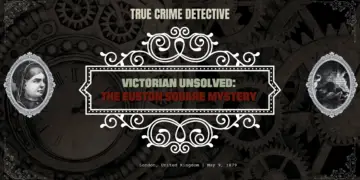
Elsie Sigel: The Body in the Trunk
Some crimes achieve infamy for the manner they are carried out, such as Jack the Ripper’s bloody reign of terror. Others, for who the victim or killer was. However, some achieve their fame by becoming a cause célèbre for the media, often latching onto moral panics of the day. These panics can come from both sides of the political spectrum, with issues such as Satanism and hate crime elevating incidents from local criminality into national scandals. One such crime was the murder of Elsie Sigel, a twenty-year-old missionary worker. Seemingly killed by her Chinese immigrant lover, the press furore surrounding the case caused the affair to have profound ramifications across the United States. Feeding into “yellow peril” fears, the murder would be one of the most shameful moments in New York City’s long history.
Elsie Sigel was described as both pretty and headstrong, being very much a new century woman. She was General Franz Sigel’s granddaughter, the German military officer who had served with some distinction during the Civil War. Franz had been an immigrant into the United States and was mainly utilized to encourage German communities to partake in the Union war effort. He forged a post-war career in journalism and lecturing before dying in 1902. At this funeral, 10,000 New Yorkers came to pay their respects, and as such, the name still carried weight, making the Sigel family prominent for their work with immigrants in the city.

Elsie’s father, Paul, had made the most of what his father had gifted him, earning a fortune in speculation through shrewd dealings and quite a bit of luck. He owned a mansion in the Washington Heights district of Manhattan and lived a comfortable existence. The Sigel position allowed them to engage in noted philanthropy throughout the city, as was primarily expected of the wealthy during the era. Elsie’s mother, Anne, taught a class for Chinese speakers at St. Andrew’s Church at 127th Street and Fifth Avenue, and Elsie herself was noted for her missionary work, offering charity and assistance to immigrant women forced into drugs and prostitution through poverty. Elsie’s work was based at the Chinatown Rescue Settlement and Recreation Room, a flophouse frequented by those in need. While there was undoubtedly a genuine concern for those struggling, it should be noted that much of this philanthropy was also to convert “heathen” immigrants to Christianity. While supportive of charity work, this wasn’t what Paul had in mind, having objected to Elsie spending time inChinatown.
During her time among the Chinese community, Elsie would often be seen in the company of a man by the name of “William” Leon Ling. The thirty-year-old Ling was said to be handsome and confident, having received romantic interest from many women. While a young woman seen out in the company of any man without a chaperone would typically have been viewed as improper during those days, nobody questioned the relationship mainly due to the difference in social status. There wasn’t any question that a woman in Sigel’s position could have feelings for a Chinese immigrant after all. Plus, Ling was well known to the Sigel family, with Elsie and her mother having first met him four years prior when he kept a restaurant on Amsterdam Avenue close to the Sigel home. The two women had visited as part of their missionary work and Ling would become a regular member at St. Andrew’s Church, sitting with the family. He was seen as a safe escort for Elsie for her time in Chinatown.

Around 10 am on June 9, 1909, Elsie left her parents’ home to visit her grandmother. She had requested to spend some time with her granddaughter in a letter received the day before. Elsie never arrived. Understandably worried, Elsie’s father, Paul, was likely ready to contact the police when he received a telegram from Washington DC three days later. Apparently, from Elsie, the telegram stated that she would “be home by end of week” and asked her father not to worry. Perhaps a little reassured, he waited. When the end of the week passed, it became clear that something was seriously wrong with his daughter, and he finally contacted the police.
Police would make their first connection in the case on June 18 when a chop suey restaurant owner visited the station and reported that his cousin, Ling, was also missing and hadn’t been seen in six days. Leon was a waiter at his restaurant. Fearing that Ling was in distress, the cousin had knocked at his door on 782 Eighth Street many times with no response. Police sent officer John Reardon over to investigate, not suspecting what was to come. Entering the room, Reardon found that Ling had departed, the room empty except for the bed and a trunk that had been tightly bound with rope. Intrigued, the officer cut through the securings and lifted the lid, standing horrified at what was inside — the body of Elsie Sigel. She had been strangled with a rope, the noose still tied around her neck. The body was almost nude and severely bloated, decomposition well underway. Elsie had clearly been there for over a week.

Now a murder inquiry, NYPD investigations soon revealed that it wasn’t only Leon Ling who was missing but also his roommate, Chong Sing. Unsure whether they were looking for a second victim or two murderers, police began a major manhunt for the duo. The link between Elsie and the pair was soon known as it was revealed that Elsie had been exchanging love letters with Leon Ling. There were thirty-five letters found hidden in Leon’s apartment, all signed by Sigel, with a similar number found from Ling at the Sigel house.
“You seem to be growing cold to me. Just think of the sacrifices I made for you — my family, my friends. For God’s sake, don’t forsake me.” — Letter from Elsie Sigel to Leon Ling.
However, Elsie wasn’t the only woman with who Ling had been exchanging letters, with over a hundred love notes discovered in all. Likewise, Leon hadn’t been the only man Elsie was interested in, with one Chu Gain also being in receipt of such affectionate missives. Gain was the manager of the Port Arthur Restaurant on Mott Street, and the police came to believe that a love triangle between the three had turned deadly. Analysis of the letters revealed that both men had known about each other, Elsie attempting to keep both. She told both Gain and Ling that she had ended her relationship with the other.
“I believe Elsie was in love with Chu Gain and would have married him, but that he would not marry her. Within the last year, despite her love for Chu Gain, Elsie became apparently infatuated with Leon Ling. But I think it was only a flirtation. He, I know, asked her to marry him, but she refused him… Her mother knew all about it.” — Florence Todd, Superintendent of the Chinatown and Bowrey Rescue Settlement and Recreation Room for Girls.
Speaking to police, Gain claimed to have been sexually active with Elsie. He added that he had recently been sent a letter that threatened Sigel’s life if he didn’t end his relationship with her. The account was supported by Elsie’s father.
“On the evening of June 8, there was a party at my house during my absence, and several Chinese were present. Leon came to the party drunk. He called Elsie to one side and told her that if she had anything to do with Chu Gain, he would kill them both.” — Paul Sigel, Elsie’s father
Both detectives and the press alike descended on Chinatown, despite the murder actually happening in Midtown. The location was already seen with suspicion by many New Yorkers through depictions of criminality in the press, “yellow peril” narratives telling of opium dens, prostitution, and violent Tongs.

The latest media frenzy caused a wave of differing reactions across the country, and many viewed Elsie as having brought about her own demise through her relationship with Leon. Indeed, letters and headlines from around the case show that many were more alarmed at the prospect of interracial relationships than they were the actual murder, one of over a hundred unsolved killings in New York at the time. After all, granddaughters of generals were assumed to be “proper” and positively not engaged in relationships with Chinese men. Many believed that irrespective of class, no white woman should be acting in such a fashion. A fresh wave of anti-Chinese sentiment swept the country. The press was scandalized and played into every trope that had defined the Asian-American experience for a century. The case quickly became a moral panic.
While the mission where Elsie worked was closed, Christian members of New York’s Chinese community convened to raise funding for a reward. Most of the community knew the Sigel family and hoped to be instrumental in capturing Leon Ling. Despite their prompt action and public condemnation of the murder, the Chinese were typically portrayed as “insidious” and “criminal,” the backlash being swift. Such was the atmosphere that Captain Arthur Carey, head of the NYPD’s homicide division, declared that Ling must have deceived the well-meaning women, openly stating his belief that the “heathen” Ling hadn’t really converted to Christianity at all. Carey believed that the suspect had utilized these methods to attempt to lure white women into his clutches.
Working in a charged atmosphere, the NYPD questioned hundreds in Chinatown, finally locating Chong Sing on June 22. Taken in for questioning, he adamantly denied any knowledge of the body in the trunk. They didn’t believe him, and Sing was both beaten and tortured over thirty hours, having no access to legal representation. Under duress, Sing was forced to confess that Leon Ling had murdered Elsie Sigel, with the New York Times publishing his confession and accusations against his friend on June 23. Tensions were inflamed almost to breaking point.
Sing claimed that he had witnessed Ling enter the room they shared in the company of Elsie, closing the door behind them. Peering through a transom window, he noticed a fight between the two, with Elsie struggling to fight off Ling as she had a handkerchief held over her mouth. Seeing blood, the next thing Sing claimed to remember was noticing Elsie laying on the bed and his friend emptying the trunk he kept in the room. Sing quickly ran downstairs towash his hands, never seeing Ling again. The NYPD wasn’t satisfied with the statement. There was no such transom, and Elsie had been strangled with a rope. Ling changed his story several times, windows becoming keyholes and times changing. Police failed to connect their violent interrogation and Sing telling them what he likely believed they wanted to hear. Sing was interrogated again and again, the brutality of the questioning leaving him “shaking violently.” Undoubtedly led, Sing eventually “confessed” that he knew the telegram that had been sent to Paul Sigel was really sent by Ling, and his friend had tried to enlist others in his crime. Those he enlisted, however, refused to move the trunk for him. It would be months before Chong Sing would be released from custody.

Meanwhile, there were still no signs of Leon Ling. Chinese men were rounded up en masse across the country and brought in for questioning for even the vaguest similarity in appearance to Ling. While police may have discriminated in terms of race, they certainly didn’t in terms of class, with those brought in ranging from laundry workers to diplomats. Several forces seemed to use the case as a pretext to move against Asian communities, arresting many on suspicion of being “accessories” to the killing where there was no possibility of claiming the detained looked anything like Ling. Koreans and Japanese were similarly rounded up without reason. With the press printing increasingly lurid tales of missionaries being seduced by Svengali-like Chinese immigrants, charity missions were closed across the country, and female teachers were quickly replaced by males. A heavy police presence in Chinatowns became the norm.
Faced with an outpouring of hatred and even violence, prominent Chinese activists and citizens protested to officials and the Chinese embassy, petitioning for protection. On July 2, a delegation from New York’s Chinatown visited Washington DC to appeal for assistance and protection both against the police and the vigilantism that had become a norm following the killing. Fearing unrest might accompany NYC’s famous Fourth of July parade, the Chinese Consolidated Benevolent Association began handing out flyers of possible violence, urging all Chinese to remain in their homes during the parade. It was almost symbolic of how the communities weren’t genuinely seen as part of America. Denigrated in the media and falsely perceived as living separately in a Chinatown enclave, Asian-Americans were present in New York but not seen as part of it. From a single murder in Midtown, the alleged actions of Leon Ling had caused a firestorm across an entire nation.
Realizing that Ling had likely long fled, it was across this entire nation that the eyes of police now turned. Reports in the media suggested that the suspect had left New York as early as June 11, the same day as the murder, travelling on to Washington DC, where he had sent the telegram to Paul Sigel. Some reports suggested that Ling had escaped dressed as a woman, merely adding to the belief in the Chinese’s innate deviousness. The claims told that he had utilized Elsie’s own clothes to escape, police noting that when Leon first came to the United States, he was known as a female impersonator with a theatrical troupe. There were alleged sightings of Ling in DC, Philadelphia, and Los Angeles, with police focusing their inquiries on New Orleans, San Francisco, and Galveston where the best tips originated. Many believed that Leon had already crossed the border and was now in Vancouver.
However, perhaps the best lead came from Texas as late as 1911. Investigating the shooting of Woo Dip, police discovered that Leon Young, a cousin of Ling, was involved in the case. An investigation suggested that Leon Ling had been staying with the family ever since turning fugitive. The lead went cold, however, and nothing was ever heard from the suspect again. Some believe that he escaped the country to Canada or China; others believed he may have committed suicide or even drowned.

What exactly transpired between Leon Ling, Chu Gain, and Elsie Sigel remains a mystery. While most favor the original police belief that Leon murdered Elsie in a fit of rage, this fails to explain why he never came for his love rival Chu Gain who had every reason to make Leon look like a killer. One theory suggests that Elsie was never murdered at all, with the noose around her neck being far more indicative of a suicide, a fearful Ling knowing that he would be accused of murder and fleeing a certain death sentence. Another theory postulated that the body in the trunk wasn’t even Sigel, with the girl actually having run away to China as Leon’s bride. This theory claims that Elsie’s family may even have been involved, helping the pair escape rather than cause a society scandal by having their love outed. However, Secret Service agents believed that Leon did indeed make his way to Canada and finally back to his homeland, ending up working on a farm for the rest of his life.
With many questions left open, the passage of time is likely to offer little resolution in a killing that had consequences that stretched far beyond the room where it happened. Having a profound effect on Asian communities for years afterwards, Elsie Sigel’s killing wasn’t merely the “Chinatown mystery” claimed by the press. Instead, it was a case where there were no winners, the NYPD and press falling far short of their duties to serve all of the public. Denigrated and maligned, the killing added new layers to “yellow peril” tropes that had already caused such misery for families that had been instrumental in the rise of the United States. Finally, we must never lose sight of the woman at the centre of the furore, Elsie Sigel, for whom there was no justice. Coupled together, the killing might very well be one of the most shameful episodes in New York’s proud history at the gateway to America.















































